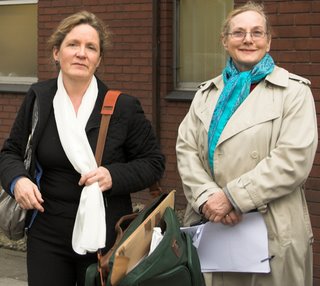 |
| Mary Jo Kowalski (left) and Dr. Hiltrud Strasser (right) at a hearing in England. |
Snippets from an article in today's
Horse and Hound:
A Suffolk (Great Britain) woman, convicted on cruelty charges linked to the “mutilation” of her pony's feet by “dogmatic adherence” to the Strasser barefoot method, has launched an appeal.
Mary Jo Kowalski was banned last week (30 August) from keeping equines for one year, sentenced to 100 hours community service and ordered to pay £10,000 towards costs. As welfare groups expressed disappointment at the leniency of the sentence, Mrs. Kowalski lodged an appeal before Ipswich Magistrates Court.
The conviction against the student of the Strasser method, who was in e-mail contact with its German founder Dr Hiltrud Strasser marks the second case of its kind this year. Dr Strasser was called as a trial witness.
Both prosecutions involved the Strasser technique, casting grave concern on the unregulated practice of radical trimming.
Britain's Farriers Registration Council (FRC) secretary Miles Williamson-Noble said the question of throwing a national safety net over the practice of trimming, which falls outside the Farriers (Registration) Act 1975, was under discussion with the National Equine Welfare Council and British Equine Veterinary Association. These talks could lead to voluntary regulation, a national code of practice and accredited training. Mr Williamson-Noble said radical trimming caused most concern as it was often done to treat conditions such as laminitis, as was the case in the two convictions.
In the first case, Warwickshire yard (boarding stable) owner Fiona Dean, 43, was fined £1,500 and ordered to pay another £1,500 in costs, for causing unnecessary suffering to a horse in her care by using the Strasser method.
“Anyone who takes a sound horse and trims its feet until it is in extreme pain is not concerned with that horse's welfare,” said Mr Williamson-Noble.
Evidence from Mrs Kowalski's trial suggested she had become “mesmerised” by the teachings of Dr Strasser. The prosecution was mounted after the RSPCA seized her pony Brambles in July 2004. The mare was found with “mutilated hooves”, walking with crossed legs, and barely able to move. She had to be put down. According to the RSPCA, Brambles was suffering from chronic laminitis affecting both front feet, but instead of calling a vet, Mrs Kowalski rasped and trimmed the pony's hooves to the point of “mutilation”.
Dr Strasser testified that, based on photographs, there was nothing to show trimming was excessive and that, merely, Brambles's hooves had “a good trim”. She said a sick pony required fresh air, not painkillers.
To learn more:
http://www.horseandhound.co.uk and
http://www.ilph.org.uk
Photo courtesy of International League for the Protection of Horses; Convicted trimmer Kowalski (left) and Hiltrud Strasser DVM, right at British court. This story was slightly edited for style and length considerations.



